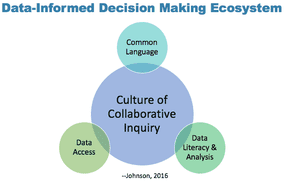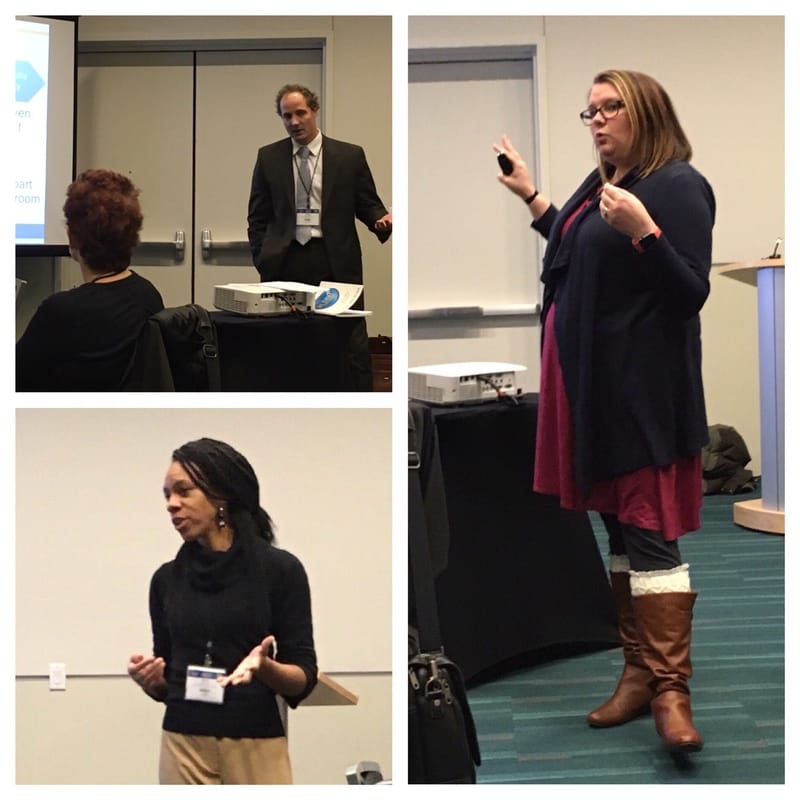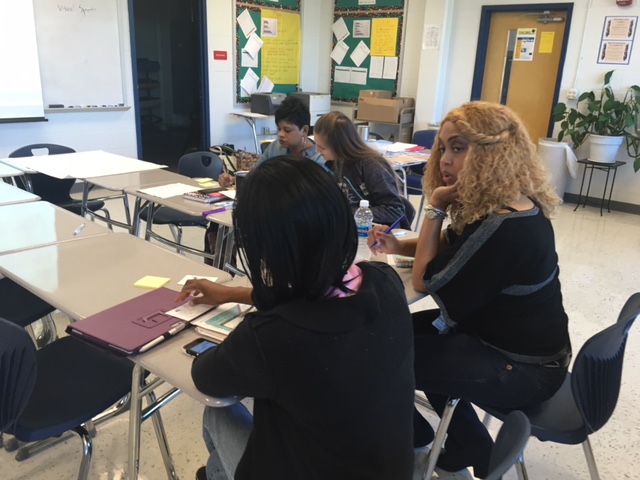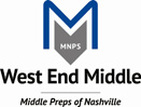|
“….collective efficacy, or the shared belief that the group will successfully achieve its goal, is a prime resource for sustained improvements in student learning” (Goddard, Hoy, & Woolfolk Hoy, 2004). On December 6, 2016, representatives from MNPS had the opportunity to present at the Learning Forward conference. The presentation, Leveraging Collaboration for Supporting Student Achievement, shared the three-year journey of MNPS’ partnership with the Regional Educational Laboratory Appalachia (REL AP) for building middle school educators’ capacities to engage in the collaborative inquiry process for raising student achievement. The presentation provided evidence-based, practical tips for translating collaborative inquiry from theory at the national level to implementation at the district, school, and classroom levels. While you can access the presentation below, here’s an overview of what was shared:


Whitney Akin, 5th grade literacy teacher at Dupont Hadley, shared how she took the idea of innovation configuration map and the collaborative inquiry process into her classroom. She has her students create an IC Map for data chats, so they know the expectations of them. She also uses the collaborative inquiry process as a literacy strategy for helping students process text. Check out her literacy handout HERE.
References: Goddard, R. G., Hoy, W.K., & Woolfolk Hoy, A. (2004). Collective efficacy: Theoretical development, empirical evidence, and future directions. Educational Researchers, 33, 2-13. Johnson, M. (2016). Experience from the field. Excerpt obtained from How to Make Data Work: A Guide for Educational Leaders, pp. 171. Lipton, L. & Wellman, B. (2012). Got data? Now what? Bloomington, IN: Solution Tree.
0 Comments
 One focus of MNPS’ Theory of Action is culture. A tool being used with some MNPS’ middle schools to gather culture data is the Culture and Climate Walkthrough Instrument developed by MNPS’ Social and Emotional Learning (SEL) department. According to Kyla Krengel, Director of SEL, the Culture and Climate rubric and walkthrough instrument was developed as a result of MNPS’ partnership with CASEL, the Collaborative for Academic, Social, and Emotional Learning. The rubric was created with input from MNPS educators and national experts and provides a common language of school culture and climate. You can access the rubric HERE. At Rose Park Magnet Math and Science Middle, we used the collaborative inquiry process to facilitate a discussion about the culture and climate data gathered at their school. Common planning teams took a deep dive in identifying key observations from the data, then proposing multiple theories of causation. Now, the leadership team is developing a survey for reaching a consensus on a theory to dive deeper into and creating a community of practice around the issue. To read more about Rose Park Magnet Math and Science Middle collaborative inquiry journey, please go HERE. If you have a collaborative inquiry story to share or need any support, please feel free to email Margie Johnson at [email protected]. I came across an article this week in Education Week entitled, Why Collaborative Inquiry? Professional Learning That Makes a Difference (DeWitt & Donohoo, 2016). While in MNPS we have been using collaborative inquiry as a data use process, after reading this article it is evident that collaborative inquiry is a process that can be used for much more.
In the article, they highlight how collaborative inquiry is a great strategy for providing high-quality, job-embedded professional learning (DeWitt & Donohoo, 2016). By using the collaborative inquiry process, teachers are put in the driver’s seat of their own learning. They are encouraged to take a deep dive into issues facing their practice and school. Through their ownership of the learning and collective wisdom, they are able to tackle complex issues, which help support student success. Of course, knowing that collaboration is the key and implementing it is two different things. Luckily, MNPS, in partnership with REL Appalachia, Dr. Laura Lipton, and Bruce Wellman, has been provided with training about the structures, strategies, and principles for facilitating collaborative teams. To learn more about this training, you can access it HERE. Also, if you are interested in participating in a collaborative inquiry community of practice to learn more about facilitating collaborative teams, please complete this form. Here’s to a wonderful December….. Reference: DeWitt, P. & Donohoo, J. (2016, November 30). Why collaborative inquiry? Professional learning that makes a difference. Education Week. Retrieved from http://blogs.edweek.org/edweek/finding_common_ground/2016/11/why_collaborative_inquiry_professional_learning_that_makes_a_difference.html?r=1680500941 |
Email Subscription
Click HERE to subscribe to receive emails for the blog posts. Archives
February 2018
Categories
All
|
||||||||
- Home
-
Workshop Warehouse
- Collaborative Inquiry for Data Use Workshop (Got Data? Now What?)
- Fishbone and Logic Model Workshop Materials
- Innovation Configurations Materials
- Creating an Evaluation Plan
- Facilitating Collaborative Inquiry Workshop (Dr. Laura Lipton)
- Group Data Exploration (PLI 2016)
- Collaborative Inquiry Community of Practice
- JE Moss Elementary Leadership Team Meeting
- 2016 NCES STATS DC Presentations
- Una Elementary Leadership Team
- Haynes Middle Prep-August 1, 2016
- August 2, 2016--Jere Baxter Middle
- 2016 NTC Nashville Analytics Conference
- Glencliff ES Leadership Team--Sept. 15, 2016
- Haynes MS Leadership Team Culture and Climate Meeting--Sept 19, 2016
- Sept 27, 2016 Two Rivers Leadership Team Meeting
- Rose Park Culture and Climate--2016
- Two Rivers SIP Goal Setting--Sept 20, 2016
- Curriculum and Instruction Meeting--Sept. 30, 2016
- Two Rivers--October 10, 2016
- John Early Culture and Climate--2016
- CTE Cohort--October 11, 2016
- Apollo Middle Milestone Meeting
- Murrell--Culture and Climate 2016-2017
- Margaret Allen--Jan 4, 2017 Culture and Climate
- Head Magnet Middle--Jan 4, 2017
- Apollo Middle--Jan 10 & 25, 2017
- IT Creswell Vision and Mission
- Dr. Springer Literacy CoP
- Two Rivers SIP Process Feb & Mar 2017
- East Nashville SIP March 2017
- East Nashville Behavior Plan May2017
- Family Engagement Data Dive
- Leading Collaborative Inquiry
- DuPont Tyler Middle Vision and Mission
- Facilitating Collaborative Teams
- 2017 SEL Conference Culture and Climate Change
- JE Moss Elementary Leadership Team Meeting--2017
- Goodlettsville Middle Vision and Mission
- CTE Cohort--July 26, 2017
- Joelton Middle Vision and Mission
- Whites Creek High Freshman Academy Vision and Mission
- Goodlettsville Middle Poverty Simulation Follow-Up Meeting
- Exceptional Education Coaches
- Hull Jackson Montessori Poverty Simulation Follow-Up Meeting
- Central Office Poverty Simulation Follow-Up Meeting
- Jones Paideia Poverty Simulation Follow-Up Meeting
- Cole Elem BHAG Fall 2017
- Cole Elem Culture and Climate--2016
- NAZA Data Dive Nov 3, 2017
- Metro Data Coord Meeting Nov 16, 2017
- 2017 Learning Forward Workshop
- Two Rivers Dec 2017 Culture and Climate
- MNPS Learning Tech Jan 2018
- MNPS SE Quadrant Leadership Meeting Jan 2018
- Margaret Allen Middle Jan 2018 Culture and Climate
- MNPS Early Learning Jan 2018
- Lakeview Elementary Jan 2018
- Wright MS SIP Process Jan 2018
- Cane Ridge HS Student Data Chats Jan 2018
- Antioch Middle Spring 2018
- Whites Creek HS Feb 2018
- 2019 Wright MS Leadership PLC
- July 2019--JE Moss Elementary Leadership Team Meeting
- Collaboration Corner Blog
- MNPS Data Guides
- Meeting Structures and Strategies
- Feedback
- Collaborative Inquiry Working Group
- Reading List
- Home
-
Workshop Warehouse
- Collaborative Inquiry for Data Use Workshop (Got Data? Now What?)
- Fishbone and Logic Model Workshop Materials
- Innovation Configurations Materials
- Creating an Evaluation Plan
- Facilitating Collaborative Inquiry Workshop (Dr. Laura Lipton)
- Group Data Exploration (PLI 2016)
- Collaborative Inquiry Community of Practice
- JE Moss Elementary Leadership Team Meeting
- 2016 NCES STATS DC Presentations
- Una Elementary Leadership Team
- Haynes Middle Prep-August 1, 2016
- August 2, 2016--Jere Baxter Middle
- 2016 NTC Nashville Analytics Conference
- Glencliff ES Leadership Team--Sept. 15, 2016
- Haynes MS Leadership Team Culture and Climate Meeting--Sept 19, 2016
- Sept 27, 2016 Two Rivers Leadership Team Meeting
- Rose Park Culture and Climate--2016
- Two Rivers SIP Goal Setting--Sept 20, 2016
- Curriculum and Instruction Meeting--Sept. 30, 2016
- Two Rivers--October 10, 2016
- John Early Culture and Climate--2016
- CTE Cohort--October 11, 2016
- Apollo Middle Milestone Meeting
- Murrell--Culture and Climate 2016-2017
- Margaret Allen--Jan 4, 2017 Culture and Climate
- Head Magnet Middle--Jan 4, 2017
- Apollo Middle--Jan 10 & 25, 2017
- IT Creswell Vision and Mission
- Dr. Springer Literacy CoP
- Two Rivers SIP Process Feb & Mar 2017
- East Nashville SIP March 2017
- East Nashville Behavior Plan May2017
- Family Engagement Data Dive
- Leading Collaborative Inquiry
- DuPont Tyler Middle Vision and Mission
- Facilitating Collaborative Teams
- 2017 SEL Conference Culture and Climate Change
- JE Moss Elementary Leadership Team Meeting--2017
- Goodlettsville Middle Vision and Mission
- CTE Cohort--July 26, 2017
- Joelton Middle Vision and Mission
- Whites Creek High Freshman Academy Vision and Mission
- Goodlettsville Middle Poverty Simulation Follow-Up Meeting
- Exceptional Education Coaches
- Hull Jackson Montessori Poverty Simulation Follow-Up Meeting
- Central Office Poverty Simulation Follow-Up Meeting
- Jones Paideia Poverty Simulation Follow-Up Meeting
- Cole Elem BHAG Fall 2017
- Cole Elem Culture and Climate--2016
- NAZA Data Dive Nov 3, 2017
- Metro Data Coord Meeting Nov 16, 2017
- 2017 Learning Forward Workshop
- Two Rivers Dec 2017 Culture and Climate
- MNPS Learning Tech Jan 2018
- MNPS SE Quadrant Leadership Meeting Jan 2018
- Margaret Allen Middle Jan 2018 Culture and Climate
- MNPS Early Learning Jan 2018
- Lakeview Elementary Jan 2018
- Wright MS SIP Process Jan 2018
- Cane Ridge HS Student Data Chats Jan 2018
- Antioch Middle Spring 2018
- Whites Creek HS Feb 2018
- 2019 Wright MS Leadership PLC
- July 2019--JE Moss Elementary Leadership Team Meeting
- Collaboration Corner Blog
- MNPS Data Guides
- Meeting Structures and Strategies
- Feedback
- Collaborative Inquiry Working Group
- Reading List






 RSS Feed
RSS Feed





